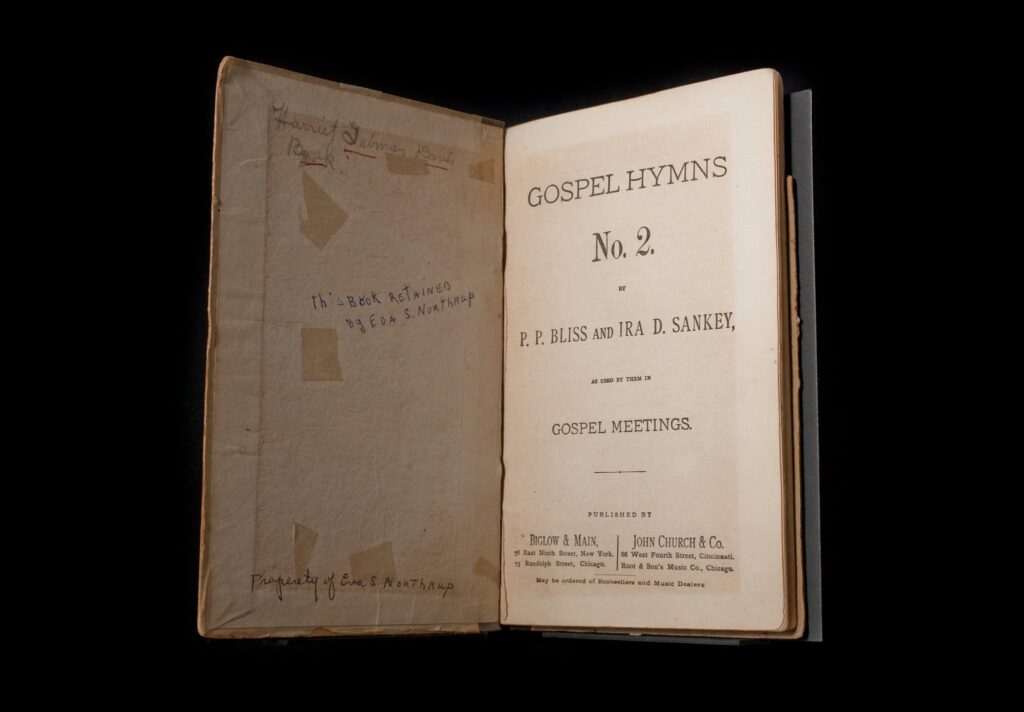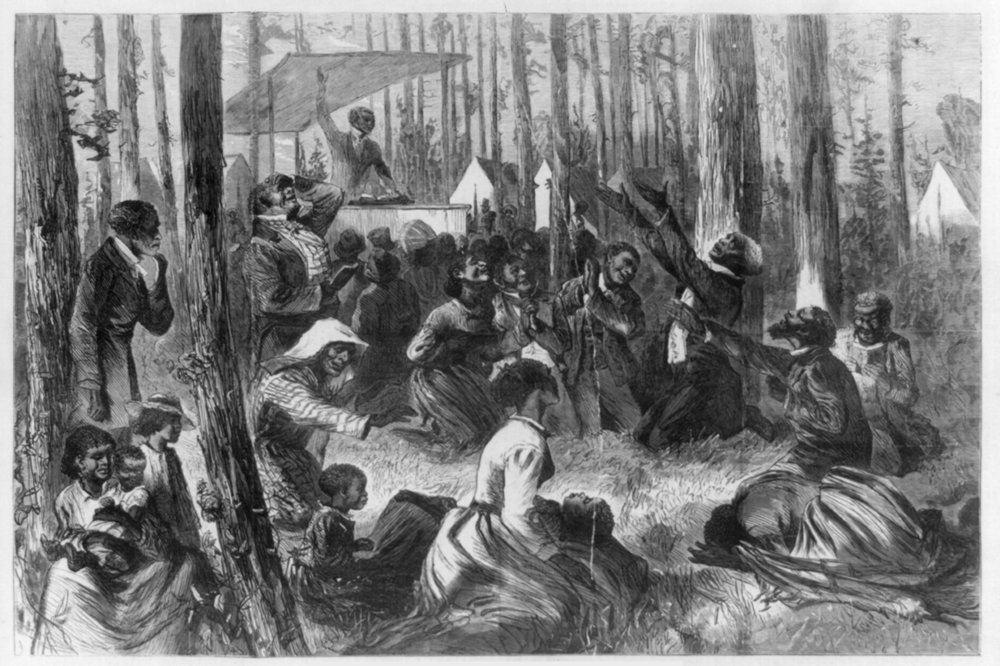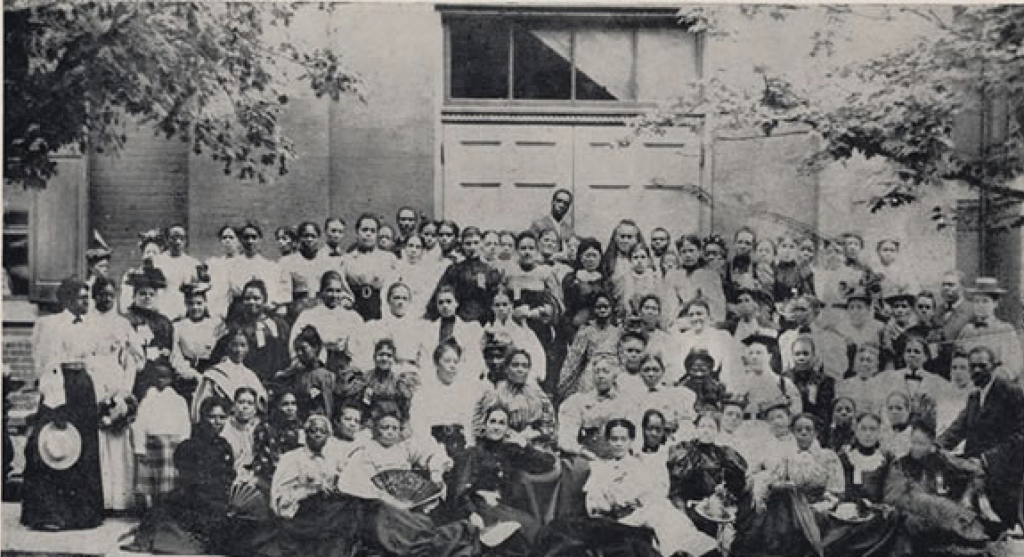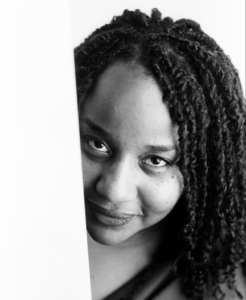
Launching Tuesday, Feb. 1, and culminating on March 10, the Harriet Tubman Bicentennial Project pays tribute to this feminist icon with a special commemorative issue through Ms. online and in print. Explore the interactive groundbreaking site here.
In spring 2019, I went on a trip to the birthplace of Harriet Tubman. Living in Washington, D.C., at the time, it was a relatively short journey to Dorchester County in the Maryland Eastern Shore where Tubman was born and raised. This was for me a pilgrimage of sorts as an African American woman who grew up in Maryland and who was raised on her legacy. It was her story, probably Sarah Bradford’s 1886 biography read aloud by my first-grade teacher for Black History Month, that first ushered me into an awareness that I descend from the only group of people enslaved in mass in the United States. I was disturbed, but my discomfort was necessary to my own life’s journey in becoming “the lion’s historian”—an ethnomusicologist who impacts the public narrative of Black music and cultures.
The longue durée of Tubman’s story in my life set me on the trajectory to be able to explore the songs she sang, and the sound world in which she lived, so that we can better understand her life. This essay is a sound collage and discussion of the early African American music culture that molded one of our most prolific ancestors.
Minty’s Childhood: African American Music Culture of the Maryland Eastern Shore
The African American sound world of mid 19th-century Dorchester County is evident through a Black American cultural tradition called generational transmission. How do we know the songs and sounds that Tubman heard and sang? African American orality. Tubman would have learned songs from her parents and grandparents, wholly informed by West African aesthetics and functionalities, but in a North American context.
Tubman’s Asante grandmother, Modesty, might have remembered the ivory talking trumpets and Atumpan drums of the Asante royal court. The Fula bamboo flutes became cane flutes, the Senegambian akonting became the banjo, and African American drums were made from local materials. West and West Central African vocal cultures would have been transformed by African American English, and West African melodies would have been adapted or simply transmitted like the one W.E.B. Du Bois’s grandmother sang, and the Mende song, a Waka, that passed down in Mary Moran’s family. The rich musical legacy of Africa would have issued forth from the Afro-descendants on the Brodess plantation.
Tubman would have heard the work songs of men who were forced to chop lumber because her father Ben Ross was a timber inspector and foreman (Larson, 31). In the morning or at the end of the day, she might have heard her mother or aunties sing prayer moans, asking God to get them through just one more day to take care of their children. As she passed the tobacco fields, she would have heard field hollers. The Singing and Praying Bands of Maryland and Delaware demonstrate how Tubman and her family might have sounded when they worshipped during secret meetings called Hush Arbors. To signal that a gathering would take place, they might have sung spirituals that operated as code songs, like “Steal Away.” These meetings reveal how Tubman would have developed the bold and unwavering Christian faith that motivated her abolitionist activism.
In the morning or at the end of the day, she might have heard her mother or aunties sing prayer moans, asking God to get them through just one more day to take care of their children. As she passed the tobacco fields, she would have heard field hollers.
Hush Arbor Faith
Harriet Tubman’s deep-abiding Christian faith was the foundation, strength and guidance for her liberation and work as an Underground Railroad conductor. Black life documented during slavery reveals her relationship with God might have been nourished during Hush Arbor meetings. These surreptitious gatherings were held by enslaved Black people all over the South, often deep in woods that abutted plantations, within a thick grove of trees in order to muffle sound. Hush arbor gatherings constituted what scholars call ‘The Invisible Institution’ or the invisible Black church—the first cohesive unit of organization that defined and facilitated the collective identity of African America. The secret, internal life of African Americans, unseen by dominant white society and slave owners, of which Hush Arbor meetings were a major part, was resistance against enslavement.
During my visit to the Brodess farm, I could not help but notice the thick, green foliage and forestry that bordered the plantation. I could imagine the quieted singing and prayers of young Minty that might have taken place amidst those thick trees.

In the Hush Arbor, Tubman might have had very real spiritual experiences, especially those of the ‘ecstatic Christianity’ that marked the second Great Awakening. She might have learned to interpret the dreams she said were from God (Bradford, 92, 115). Understanding the Hush Arbor tradition reveals the sacred culture that led to the kind of faith that Harriet Tubman expressed, witnessed and proclaimed by all who knew her.
I could not help but notice the thick, green foliage and forestry that bordered the plantation. I could imagine the quieted singing and prayers of young Minty that might have taken place amidst those thick trees.
Underground Railroad agent Thomas Garrett said about her: “I never met any person of any color who had more confidence in the voice of God as spoken direct to her soul, and her faith in the Supreme Power truly was great.”
In both her 1886 biography by Sarah Bradford, and subsequent biographies, it is the voice of God in Tubman’s life that helped to facilitate the bold exploits of liberation that she would perform later in her life. She told Sarah Bradford that God gave her dreams that either foretold the future (her life as a liberator and the outcome of the Civil War) or that warned her of danger (92, 115, 118). She testified that God would speak to her during freedom journeys to re-direct her path away from danger (74). Tubman kept faith that “God was watching over everything and one day all would be set right.”
Songs for Liberation
By all accounts, Harriet Tubman had a lovely singing voice (Larson, 331). Tubman was a singer. She used songs to facilitate escapes, starting with her own. Although she nurtured a life-long aspiration for freedom, she made the decision to run after learning she was going to be sold in 1849. She surreptitiously let her family and friends know what she was doing by singing the song ‘Bound for the Promised Land’ as a code song. The song was either an African American spiritual or a modified Methodist hymn, as some scholars argue. Based on the lyrics and melodic structure, it was probably a spiritual.
There is much we can infer from this story. If she sang the song as an encoded goodbye, then her family would have known the song, and it is likely that they sang it together during Hush Arbor meetings. The Promised Land, in African American spirituals, had a triple meaning that referred to either Israel for the Biblical Hebrews, heaven in the afterlife, or the Free North. Her family would have known the code, but slaveholders would have been unaware. This reveals the extent to which the inner life of enslaved African Americans was well hidden from Euro-Americans and useful for survival and freedom. Moreover, if her owner was not suspicious of her sudden outburst of song, it probably means that Tubman often sang loudly.
Harriet Tubman used code songs as signals, instead of verbal directions, to direct the groups of freedom travelers that she led. She sang a hymn called “Hail, Oh Hail, Ye Happy Spirits” to communicate her return to the woods where a group hid while she went to get food (Larson, 231).
As shown in the opening soundscape, she also sang what seems to be a variation of the spiritual “Go Down Moses” to signal danger (Larson, 232). Also, in an encoded 1854 letter to Jacob Jackson in Maryland, she craftily warned him to be ready for a freedom journey, saying that he should be on the lookout for that “Old Ship of Zion,” the title of another African American spiritual.
At the end of her well-known journey that led Josiah Bailey out of bondage, she made merriment with the group when they crossed over Niagara Falls into Canada by singing “I’m On My Way to Canada” (Bradford, 49-50 ). This song has palimpsestic lyrics to the tune of “Oh Susana.” Finally, during one of her last liberation exploits as leader of the Combahee River Raid during the Civil War, she sang a song with the lyrics “Come Along, come along, don’t be a fool/ Uncle Sam is rich enough to give us all a farm,” apparently to focus the Union soldiers and escapees on their mission and to calm them (Bradford, 101-102). The song was composed in 1848 by the Hutchinson Family, who were famous abolitionist singers from New Hampshire.
These are the documented songs that Tubman sang to facilitate freedom escapes, but it is likely that she engaged many more from the treasure trove of spirituals and hymns that were the mainstays of African American culture during that time. Some of those possibilities are included in this section, along with a final soundscape of the crossing over Niagara Falls into Canada that Tubman made many times while leading souls to freedom.
Faith and Favorites During Freedom
After her escape in 1849, Tubman lived in the Urban North – Philadelphia, St. Catherine’s Canada and finally in Auburn, New York. Her song-life would have included popular tunes of the day (showtunes), the spirituals, and hymns sung in the A.M.E. Zion church, a traditional African American denomination in which she was a long-time member, along with Frederick Douglass. After the Civil War, she continued to be known for her powerful singing. Tubman sang often as a member of the A.M.E. Zion Church in Auburn and at her speaking engagements, and during interviews. Florence Carter, a widow of the pastor of Tubman’s church, remembered “Tubman had a fine voice, that was very feminine, and when she sang, as she did often, her lung opened widely and she would shout.”
According to an Auburn resident, one of Tubman’s favorite songs to sing at church was “Get On Board Little Children,” also known as “The Gospel Train.” This song well narrates her life’s work as an Underground Railroad conductor, in which she said that “she never lost a passenger.” Carter’s memory also documents that African American spirituals were frequently sung at Tubman’s church – the repertoire of spirituals was probably not limited to just “The Gospel Train.” While we cannot know all of the songs Tubman sang while attending church services, the contemporary hymnal is full of hymns and traditional African American spirituals.

Shortly before the Civil War, Tubman began to give public lectures in 1859 to raise funds to support her parents. She told her abolitionist audience stories of her enslavement, escape, and journeys back to the South to free others. She became well known for her storytelling ability. Tubman might have also performed spirituals and hymns during her public lectures (Larson, 209). She sang at the founding convention of the National Association of Colored Women in 1896. She also sang spirituals during an intimate visit with Agnes Garrison and Eliza Wright Osborne in 1899. Encouraged by Osborne, Tubman told her “narrative” and “acted out parts of it” … “singing one of the old songs in a curious, nasal, mournful voice” (Larson, 302).
At the very last moments of her life, on March 10, 1913, Harriet Tubman passed into eternity surrounded by song. Clergy from the A.M.E. Zion church, family members and friends sang either hymns, spirituals or both at a final service that she directed. She joined in the singing when she could, took a final communion, then slipped into a coma and on into Glory.
Legacy/Progeny
Harriet Tubman’s use of songs for Black liberation serves as a kind of urtext of what became a long standing African American cultural tradition. As we know from Tubman’s faith life after slavery, and through other ethnographic evidence, African American spirituals remained the song-staples of many African American churches and were passed down to subsequent generations. There is a lineage of African American women and men who, like Tubman, have used Black songs in activism, drawing from the corpus of African American spirituals to advance Black Freedom.
In 1849 Harriet Tubman prophetically sang that she was “Bound for the Promised Land,” and in 1968 the Rev. Dr. Martin Luther King, Jr. declared that “we as a people will get to the Promised Land.” As I perform and record Tubman’s songs, and write curricula that culturally affirm African American children by teaching them their history and African American/African heritage, I am doing my part to help Black people reach the ‘Promised Land’ goal. Standing on the Brodess Plantation back in 2019, watching the tall grasses and flowering trees nod in the gentle northward breeze, I learned something from Tubman that can only be fully known by observing the land of her childhood. Its isolation led me to ask how, from this middle of nowhere place, could a young Black girl born into slavery, who was at every disadvantage, rise to become one of the most widely recognized people in American history? The land, her story and her namesake freedom song tell the answer. Go down Moses, way down in Egypt land. Tell old Pharoah, let my people go. Like Moses of the Bible who was “slow of speech and tongue,” and the Moses of her people who had fainting spells, our weakness and the obscurity that we start in does not matter. With courage, faith and God on our side, we win.
The essay series for the Harriet Tubman Bicentennial Project includes:
Michelle D. Commander, “Let Me Not Forget: Harriet Tubman’s Enduring Speculative Visions” | Feb. 2
Chanda Prescod-Weinstein, “Harriet Tubman, Astronomer Extraordinaire” | Feb. 3
The Life of Harriet Tubman
Kate Clifford Larson, “Harriet Tubman: A Life Beyond Myths” | Feb. 8
“Family Portraits of a Legend: Conversations with the Descendants of Harriet Tubman” | Feb. 9
Deirdre Cooper Owens, “Harriet Tubman’s Disability and Why It Matters” | Feb. 10
The Untold Stories and Songs of Harriet Tubman
Edda L. Fields-Black, “‘Harriet’ and the Combahee River Uprising” | Feb. 15
A Conversation with Music Composer Nkeiru Okoye | Feb. 16
Maya Cunningham, “The Sound World of Harriet Tubman” | Feb. 17
Imagining Harriet Tubman
Amy Corron and Rebecca Rouse, “Why Video Games Education Needs Harriet Tubman” | Feb. 22
A Conversation with Artist Nettrice Gaskins | Feb. 23
Michele Wallace, “Harriet Tubman in the Art of Faith Ringgold” | Feb. 24
Rediscovering Harriet Tubman
Jonathan Michael Square, “The Two Harriets” | March 1
A Conversation with Karen V. Hill, Director of the Harriet Tubman Home | March 2
Douglas V. Armstrong, “Using Archaeology to Rediscover Harriet Tubman’s Life in Freedom” | March 3
Celebrating a Legacy
Keisha N. Blain, “Justice and the Meaning of the Tubman $20” | March 8
A Conversation with Mary N. Elliott, Curator of American Slavery at the Smithsonian Museum | March 9
Harriet Tubman Syllabus | March 10
Questions or press queries about the series? Contact tubman200@msmagazine.com.






